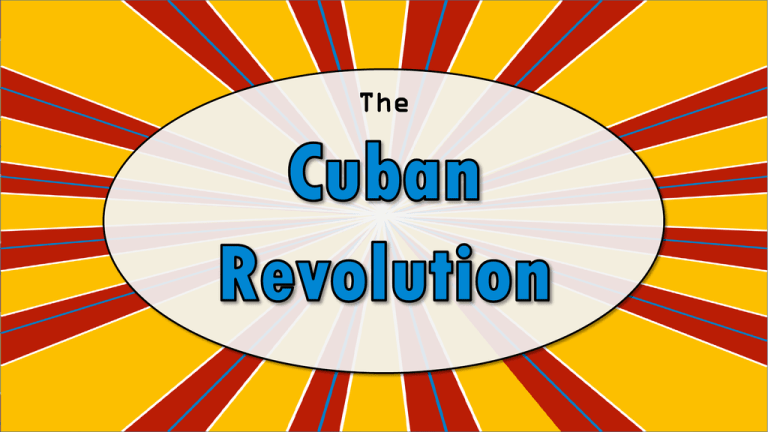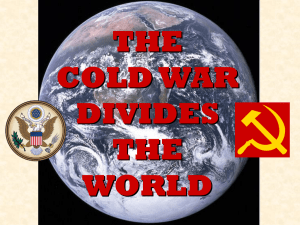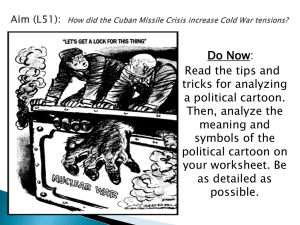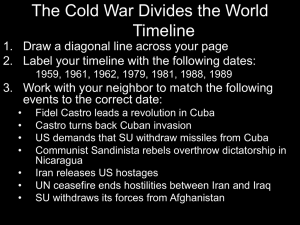
The
Standards
SS6H3 The student will analyze important 20th century issues
in Latin America and the Caribbean.
a. Explain the impact of the Cuban Revolution.
Teachers
Print off the following page for each student.
They should complete the graphic organizer
while discussing the presentation.
The
Where is Cuba?
• Cuba gained its independence from Spain in 1898.
• In the 1900s, Cuba’s wealth was controlled by
American companies.
• The main businesses in Cuba were sugar and
mining companies.
• The leader of Cuba was Fulgencio Batista.
Fulgencio Batista
•
Fulgencio Batista had originally been elected as president, but
made himself dictator of Cuba.
•
Many people were unhappy with Batista’s rule.
• Poverty was abundant, education was poor, and healthcare
was limited.
•
Social and economic problems helped lead to the unrest of many
Cubans.
• There was a small class of rich Cubans with all the power,
while the majority was very poor and had little to no power.
• Soon, revolutionaries lead by Fidel Castro began to rise up against the
government.
• Castro and his forces led an unsuccessful overthrow of the government in
1953, but began a full scale war against Batista’s government in 1955.
• Castro attempted to overthrow Batista’s government for seven years.
• Castro and his “army” lost many battles to Batista – he was even
arrested and sentenced to 15 years in jail!
• Castro was released in 1955 after serving only two years and fled to Mexico
to put together a new group of rebel fighters.
• By 1959, Castro and his men drove Batista and his supporters out of Havana
and took over the government.
Fidel Castro
Castro Released from Prison
• In 1959, Castro defeated the Batista government.
• Castro seized absolute power and made himself
dictator of Cuba.
• He then had 700 of his enemies executed and many
more were thrown in prison.
• The US originally backed Castro because he promised
to make Cuba a democracy…
• US even sent him supplies to help defeat Batista.
• Castro promised to:
• end American dominance over Cuban
businesses,
• re-distribute the wealth evenly to all Cubans,
• make every Cuban literate,
• and he wanted to give all Cubans healthcare
and higher life expectancy.
• Castro failed to do many of the things he promised he would do.
• Castro began organizing a Communist government right away:
• He declared that all property belonging to Americans now belonged to
the Cuban government.
• All farms, factories, & businesses now belonged to the government.
• Cubans no longer had the right to protest against the government.
• Cuban newspapers, radio, & TV were shut down.
• The government became the only source for news.
• Churches were closed and property was taken over by government.
• Castro’s government gave less freedom to Cuba’s citizens.
• It was the ultimate goal of Fidel Castro to break ties between Cuba
and the United States.
• After the revolution, relations between the American government
and Cuban government got worse and worse.
• US didn’t like having a communist country so close.
• US didn’t like Cuba having ties with the Soviet Union because
they were involved in the Cold War.
• Americans who owned land and businesses in Cuba lost their
property.
• Castro forced American civilians to leave Cuba.
• This was a plan to arm Cuban exiles living in Florida and
send them to Cuba.
• Once the exiles arrived in Cuba, unhappy Cubans
would join them at the Bay of Pigs and they would
overthrow Castro.
• The invasion was a disaster because Castro’s forces
intercepted the plan and captured the invaders.
• No rebellion against Castro occurred, but this sparked
a deep hatred for the United States.
Captured During Invasion
• In October of 1962, US planes spotted secret Soviet missile bases
in Cuba.
• President Kennedy announced to US citizens that the Soviets
had placed long-range missiles in Cuba.
• This was an extremely TENSE time (height of the Cold War)
that could have led to WWIII.
• Resolution:
• President Kennedy agreed not to invade Cuba and to remove
US missiles from Turkey; in return, Khrushchev agreed to
remove the missiles from Cuba.
Missiles in Cuba
Missiles’ Range
• Due to the harsh events, US placed an embargo on
goods from Cuba in 1962.
• Cuba’s sugar cane crop could no longer be sold in
the US, which hurt Cuba’s economy.
• The embargo is still in place today.
• As a result of the embargo, poor harvests, and bad
government planning, Cuba’s economy has become
very poor.
October 23, 1962: President
Kennedy signs the bill to
place a trade embargo on
Cuba.
• Relations have not improved much over the past 50+
years.
• There is still an embargo on goods to/from Cuba.
• In the early 1980s and 1990s, there were periods in which
large numbers of Cubans escaped their island for
America.
• Thousands of Cubans left because Castro would not
allow free elections, freedom of speech, freedom of
press, etc.
Cuban Refugees
• After a decline in health, Fidel Castro gave up the
Cuban presidency on February 19, 2008.
• His brother, Raul Castro, is now the Cuban
dictator.
• Most Cubans despise the Castro regime, but are
too afraid to oppose the government.
Raul & Fidel Castro
POSTER -- Draw and color your poster. It must include:
• An image or scene that represents the “movie”
• The title of the movie—“The Cuban Revolution” (or something
similar)
• The “actors” in the movie – (“starring Fidel Castro”, etc.)
REVIEW – Answer the following questions on the back of your poster.
Please write in complete sentences!
• Summarize the Cuban Revolution.
• Summarize the main people involved in the Cuban Revolution.
• Give your opinion of the Cuban Revolution.
• How many “stars” out of 4 would you give it? Why?
Teachers – Castro Mini-Centers Directions
Put the students into six groups. Print off the
Center slides. The students will rotate through
the six centers and complete the graphic
organizer.
Your Task: Rotate through each Castro Center and complete the
graphic organizer. You will only have about 5 minutes at each center,
center, so work quickly!
Center Guidelines:
1. Keep all materials at the table.
2. You may only talk with people in your group.
3. Write all of your answers on the graphic organizer,
4. When the timer goes off, it’s time to move to the next center.
5. Turn in your graphic organizer for a grade!
Teachers
Thank you for downloading this file. I hope you enjoy using it with your students, and
I can’t wait to read your feedback in my TPT store!
• For more social studies materials, please visit my store:
http://www.teacherspayteachers.com/Store/Brain-Wrinkles
• I teach Language Arts and Social Studies in Georgia, so my products are aligned
with Common Core (LA) and Georgia Performance Standards (SS).
© Copyright 2013. Brain Wrinkles. All rights reserved. Permission is granted to copy pages specifically designed for student or
teacher use by the original purchaser or licensee. The reproduction of any other part of this product is strictly prohibited.
Copying any part of this product and placing it on the Internet in any form (even a personal/classroom website) is strictly
forbidden. Doing so makes it possible for an Internet search to make the document available on the Internet, free of charge, and is
a violation of the Digital Millennium Copyright Act (DMCA).
Credits:
All photos were found via Creative Commons and labeled for reuse.
• Fonts:
• Backgrounds & Graphics:








